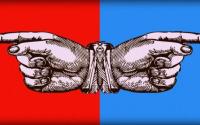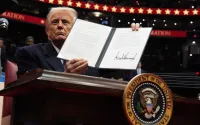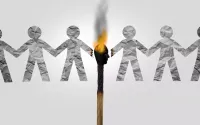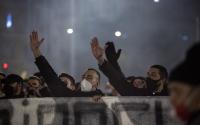ZnetOctober 17, 2003
What is happening in Bolivia?
A massive popular mobilization is demanding the resignation of the President, Gonzalo Sanchez de Lozada, and several ministers, including the Minister of Defense. On October 16 hundreds of thousands of demonstrators filled the main square in La Paz, Bolivia’s capital. The presidential palace, guarded by tanks and trenches, is surrounded by demonstrators.
The mobilization arises out of a non-violent movement primarily involving Aymara peasants, an indigenous group making up about a quarter of Bolivia’s population, based in El Alto, an Aymara city of some 700,000, but now extending according to Forrest Hylton, a knowledgeable researcher on Bolivia, to“the hillside neighborhoods of Upper Miraflores, Munaypata, Villa Victoria, Villa del Cármen, Villa Fátima and the Cemetery of La Paz”. (1)
In September, the movement had grown, in Hylton's words, to encompass "Rural and urban schoolteachers; students studying to be schoolteachers; parents of conscripts; retired miners; Aymara peasant leaders; inter-provincial truckers; university students from El Alto; the Bolivian Workers’ Central (COB); all are on strike, some on hunger strikes. In addition to sectoral demands, each organization clamors for popular sovereignty over Bolivian gas and rejects the FTAA; most demand the resignation of Sánchez de Lozada and his draconian ministers, Yerko Kukoc, Minister of Government, and Carlos Sánchez de Berzaín, Minister of Defense, who are responsible for the massacre in Warisata on September 20, in which six Aymara community members—including eight year-old Marlene Nancy Rojas Ramos—were murdered after government forces moved in to evacuate several hundred tourists stranded for five days in (the town of) Sorata by road blockades. The massacre, let us note, took place the day after the National Coordination for the Defense of Gas mobilized 30,000 people in (the city of) Cochabamba and 50,000 in La Paz (the capital). In response to state terror, which made use of planes and helicopters, poorly armed but strategically placed Aymara community militias drove the army and police out of Warisata, Sorata and Achacachi.” (2)
The movement’s demands, in addition to the resignation of the President, are the formation of a new Constituent Assembly and a repeal of the privatization and foreign investment laws.
The movement has been met with terrible repression. There was a massacre in late September, and dozens more have been killed by police and security forces over the past week. About 60 people have been killed in the past month, with hundreds more injured, nearly all by bullet wounds from security forces. (3, 4)
What are the immediate roots of the current crisis?
The crisis is being called the ‘Gas War’. It began with the government’s plan for a $5.2 billion dollar natural gas pipeline project, controlled by a consortium of multinational energy companies including Repsol/YPF SA, British Gas (UK), Pan American Energy, BP PLC (UK), and Bridas Corporation (Argentina). This project was to export Bolivia’s natural gas to the United States, via Chile.
While much is being made in the mainstream media about popular resentment of Chile (Bolivia lost its outlet to the sea in an 1880 war with Chile) and the possibility of a Chilean port being used to export the gas, the movement’s aims probably have more to do with self-determination than with this type of nationalism. In analyst Tom Kruse’s words:
“Bolivia has enormous reserves of natural gas. However, how the gas is to be exploited, and who the benefits will accrue to, are heated political issues in Bolivia. There is good reason for the heated debate: Bolivia has passed through 3 major cycles of non-renewable commodity exports: silver through the 19th century, guano and rubber later that century, tin in the 20th century. These cycles for exports never laid the basis for a prosperous, productive and just society. On the contrary, Bolivia is one of the least prosperous and most unjust societies in Latin America. The question Bolivians are rightly asking is, ‘how will this next round of non-renewable commodity exports be turned into real development?’” (5)
As Kruse notes, natural gas is now Bolivia’s most important resource. But because of privatization and the rules governing private investment, the country captures very little benefit from the resource. Exporting $1.2 billion of natural gas to Brazil has brings the Bolivian government $90 million in revenue. The sale of gas to the US would benefit Bolivia little more.
The President, Gonzalo Sanchez de Lozada (also known as ‘Goni’), has suspended the natural gas project and declared that he would accept a referendum on the issue. But after the massacres, the movement is refusing to stop short of his resignation. The Vice President, Carlos Mesa has distanced himself from Goni.
What are the historical roots?
The current conflict is a continuation of a mass mobilization that occurred in January-February of 2003. At that time, a movement of campesinos demanded the suspension of coca eradication, the repudiation of the Free Trade Area of the Americas, and re-nationalization and an end to privatization. The security apparatus nearly divided (as it may yet do), but in the end remained with the government and repressed the movement, with over 20 killed and many more injured. (See Sebastian Hacher’s reports, and others, on Bolivia Watch.) (6, 7)
The elections of June 2002 set Bolivia on the road to the current crisis as well. In those elections, a new party, the Movimiento Al Socialismo (MAS) led by Evo Morales, a representative of the coca growers of the Chapare region, came very close to winning the election. MAS is a coalition of social movements, including peasants and worker’s unions, with a strong stance against privatizations and corporate globalization. With 625 000 votes (22.46% of the registered voters), Goni’s Movimiento Nacional Revolucionaria (MNR) was able to form a minority government in coalition with some other parties. MAS had won 580 000 votes (20.94%), after stern warnings from the United States Embassy that there would be reprisals of Morales’s MAS were to win the elections. Despite his very shaky support and minority government, Goni treated his election and his US support as a mandate for aggressive neoliberalism and the drug war. Given that the popular movement’s grouping, MAS, had just won a near-upset victory itself, it was in a good position to mobilize against Goni’s program.
Bolivia has been the site of remarkably resilient and powerful people’s movements, which managed to stop the privatization of water in Cochabamba in 1999-2000. (8)
Also important is the neoliberal ‘opening’ of the country itself in 1985. The decree (now famous, numbered 21060) was passed by President Victor Paz Estenssoro to stop inflation. It succeeded in stopping inflation by plunging the country into recession and beginning the period of structural adjustment. The tin mines, the main source of national revenue at the time, were sold to multinational corporations at very low prices with no benefit to the population. The state industries, which had been the basis of the national economy and its social welfare programs, were privatized. (9)
Paz Estenssoro was one of the presidents during the revolutionary period 1952-1964, when the mines were nationalized, the national union central was created, and universal suffrage enacted. It is ironic that he presided over the dismantling of the socially progressive programs his government had enacted decades before.
Between 1964-1982, with only brief interludes of civilian rule, Bolivia was ruled by repressive military dictatorships. The aspirations of the indigenous peasant majority were suppressed, as was organized labor and dissent generally, even though these powerful social sectors were never destroyed. Their rising expectations, especially those of the indigenous who today refuse to be excluded as they have historically been excluded, are crucial background in understanding Bolivia.
Who are the main actors? What are their interests and demands?
On the one side there are the popular movements, whose composition and demands have been described above. Not only do they have powerful support from the MAS in the parliament itself, but even the Vice President has renounced the violence of the regime.
Goni is a multi-millionaire with diverse mining and business interests and a long history in Bolivian politics (president between 1993-1997, for example, presiding over various privatizations). He is famous for speaking Spanish with a thick American accent and is known as ‘the gringo’.
As for Goni’s regime itself, its supports are the mainstream media, the United States, and the repressive apparatus of the state. According to Forrest Hylton, even the middle class is beginning to defect, repudiating the violence of the regime: “The emergence of a middle class opposition is a new and welcome development that may tip the balance in favor of the Aymara working class and peasantry in the epicenter of conflict. “
Hylton sees two possible ways out of this impasse. The first is horrific to contemplate: “Sánchez de Lozada is negotiating with Manfred Reyes Villa, leader of the NFR (Nueva Fuerza Republicana, a party of the right that came in third in the 2002 election and is part of Goni’s coalition) and once he has the support of Reyes Villa, Sánchez de Lozada will most likely declare a State of Siege. The president and his closest allies have calculated that by killing three to four hundred opposition leaders, intellectuals and students, and detaining between one thousand and twelve hundred, they can “pacify” the country. Though four US military officials are directing operations on the ground; though thousands of troops have been flown in from the eastern lowlands of Beni, Santa Cruz and Pando; and though the military high command issued a communiqué on October 13 in support of Sánchez de Lozada, a massacre of gross proportions a la Pinochet may be out of the question, because an important current within the high command recognizes the democratic nature of popular demands and would like to see the Minister of Defense, Carlos Sánchez Berzaín, dead. A State of Siege entailing mass killings and detentions could easily divide the army, at which point the war cry of the unarmed Alteños—‘now for sure, civil war’—could materialize.” The alternative is “that with the backing of the opposition movements, and before it’s too late to stop the bloodshed, Vice-President Carlos Mesa calls an extraordinary session of Parliament to demand Sánchez de Lozada’s resignation, the repeal of the laws regulating privatization and multinational investment, and the formation of a Constituent Assembly. Fifty-one years after its first national revolution, which brought the MNR to power, Bolivia is ready for another—one which will bury the MNR once and for all.” (10)
What is the role of the United States?
The United States is backing Goni, who has accepted US drug war policies and IMF economic prescriptions wholeheartedly. State Department spokesman Richard Boucher said the US ``will not tolerate any interruption of constitutional order and will not support any regime that results from undemocratic means.'
This is a rather far cry from the US’s behavior in April 2002, when it endorsed the military coup against Venezuela’s president Chavez. At the time, the Venezuelan opposition shot several Chavez supporters and claimed that Chavez was responsible [see Wilpert’s eyewitness account and material since (11)], claiming that Chavez should resign because of his responsibility in the deaths. The US repeated the Venezuelan opposition’s claim that Chavez should resign because of these deaths, and that they essentially legitimated a military coup. But when Goni’s regime is undoubtedly guilty of what Chavez’s regime was accused of without such unequivocal evidence, the US insists that it “will not support any regime that results from undemocratic means.” Meanwhile, as Hylton noted, US officials are helping to direct the repression on the ground.
The US’s drug war policies have helped bring Bolivia to a boiling point. Coca leaf has been a key crop in Bolivia and throughout the Andean region for centuries, because of its nutritional value. During the centuries of mining exploitation, chewing coca leaf was indispensable for the survival of workers at high altitudes. After the neoliberal opening, coca became the only crop that enabled campesinos to earn a living – other crops did not fetch an economic price on the market and price supports were no longer available. A Foreign Policy in Focus review said of the US policy of eradicating coca farms that ”aside from destroying the country’s economy without providing alternatives, it has led to a greatly increased military presence in the Chapare coca-growing region and to widespread harassment, torture, and even murder of its indigenous people.” (12)
The repression of coca growers was a ‘success’ in Bolivia: it displaced most coca production from Bolivia to Colombia. Now, Colombian peasants are being fumigated by the US drug war, while Bolivian peasants have been left with no livelihood and no recourse but to mobilize, and there has been no appreciable effect on drug consumption or abuse in the United States.
Also, historically, the US has trained some of the most repressive dictators in Bolivian history at its School of the Americas, among them Hugo Banzer, whose remarkable career and long links to the US are detailed in a story by Jerry Meldon (13)
US intervention in the region, based in Colombia and Ecuador, is increasing, targeting popular movements like that of Bolivia and regimes like that of Venezuela.
What is the role of the IMF?
The conflict is, at its core, about corporate ‘globalization’ of the type prescribed by the IMF. The IMF’s structural adjustment programs, demanding reductions in public services, privatizations, and recessionary policies that throw people out of work, have been crucial in bringing the country to the crisis point. Neoliberalism is partly responsible for the 70% poverty rate in Bolivia. The natural gas exportation project itself was one encouraged by the IMF.
The struggles of Bolivia’s popular movement are for self-determination against the outside control of institutions like the US, multinationals, and the IMF.
What is Bolivia’s makeup?
Bolivia has about 8.5 million people. The indigenous are a majority in Bolivia, with the Aymara about 23% and Quechua 27% (statistics cited in Herbert Klein’s ‘Concise History of Bolivia’, 2003). Despite its wealth of resources, it has long been one of Latin America’s poorest countries with some of the lowest human development indicators. Neoliberalism has not helped in this, destroying the important state sector, reducing employment in a country wracked by unemployment and underemployment, and reducing social protections.
What can people outside do?
If a solution is not found, this crisis could end in a terrible repression. The United States seems to have vowed to back Goni to the end, but he is immensely unpopular. This is a case where international attention and solidarity can make a difference. A handful of US citizens have prepared a sign-on letter to the US government. (14)
Indigenous activists in Colombia and movements elsewhere in the region are working on actions in solidarity with the Bolivian movements. Predictably, the mainstream media has been paying almost no attention to these incredibly important events. Breaking that silence and communicating what is happening is crucial now, as it was in the ‘water wars’ of 1999-2000.
Where can I learn more?
ZNet’s Bolivia Watch is presenting the analyses we can find in English . Other sites are posting analyses by writers like Forrest Hylton, Ben Dangl, Kathyrn Ledebur, and others. Translations are becoming available at Indymedia Bolivia
Links
1. http://www.zmag.org/content/showarticle.cfm?SectionID=52&ItemID=43602. http://www.zmag.org/content/showarticle.cfm?SectionID=52&ItemID=42993. http://www.zmag.org/content/showarticle.cfm?SectionID=52&ItemID=43424. http://www.zmag.org/content/showarticle.cfm?SectionID=52&ItemID=42455. http://www.zmag.org/content/showarticle.cfm?SectionID=52&ItemID=43596. http://www.zmag.org/content/showarticle.cfm?SectionID=20&ItemID=30447. http://www.zmag.org/content/showarticle.cfm?SectionID=20&ItemID=29718. http://www.thirdworldtraveler.com/South_America/Bolivia_WaterWarVictory.html 9. http://www.essential.org/monitor/mm2000/00june/interview.html10. http://www.zmag.org/content/showarticle.cfm?SectionID=52&ItemID=436011. http://www.zmag.org/content/LatinAmerica/wilpertcoup.cfm12. http://www.fpif.org/briefs/vol5/v5n38bolivia.html13. http://www.consortiumnews.com/archive/story40.html






